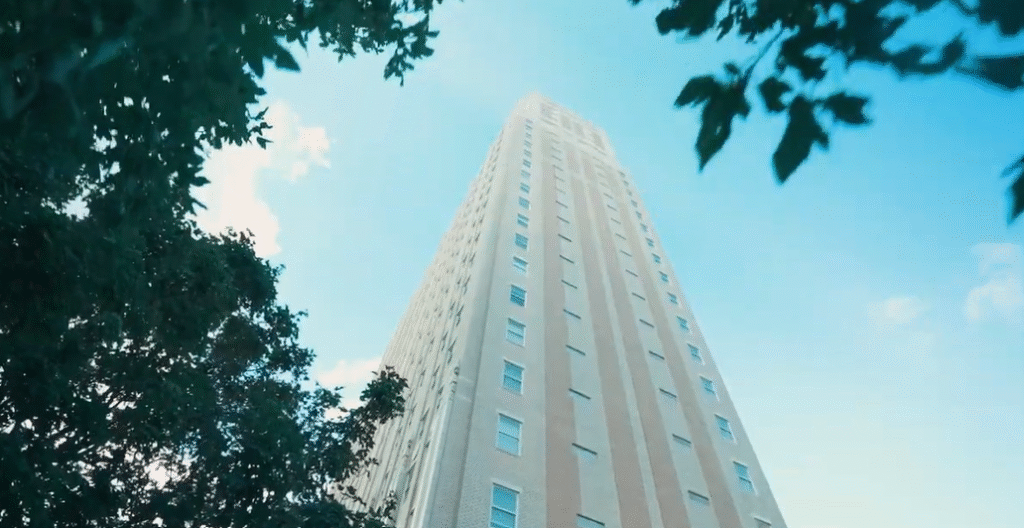For many who have lived, worked, or just passed beneath its towering spires, 909 Walnut, which rises gracefully above Kansas City’s urban grid, has an architectural and profoundly emotional presence. Constructed in 1931 at a time when the nation was especially uncertain, its very existence seems to be a silent act of defiance—a building founded on ambition when hope was few.
Since it was first commissioned by Fidelity National Bank & Trust, the building’s function has changed continuously, adjusting to the times with remarkable ease. Under the Truman administration, the U.S. government converted it into a federal office building in the postwar period. During the Cold War, Kansas City was at the forefront of meteorological advancements thanks to the landmark’s housing of the Severe Local Storms Warning Service, a crucial weather forecasting unit. A steel-framed radome was then situated high between its spires, transforming 909 Walnut into a landmark for science as well as aesthetics.
The building’s future appeared uncertain by the end of the 20th century. It remained mostly empty after the government left in 1995. However, 909 Walnut was reborn instead of quietly accepting the fate of decay, which many historic towers have accepted. After being acquired by Simbol Commercial Inc. in 2000, the building underwent a comprehensive renovation project costing $64 million. More than 100,000 square feet of commercial office space and 159 upscale apartments were added to the downtown Kansas City area as a result of this transformation. A particularly creative approach to sustainable urban living was introduced by the adjacent garage, which is notable for having a beautifully designed rooftop garden on top.
909 Walnut — Key Facts & Building Information
| Attribute | Details |
|---|---|
| Name | 909 Walnut |
| Location | 909 Walnut Street, Kansas City, Missouri |
| Year Completed | 1931 |
| Height | 471 ft (144 m), with twin spires reaching 498 ft |
| Floors | 35 |
| Architectural Style | Art Deco with Gothic Revival elements |
| Original Purpose | Fidelity National Bank & Trust Headquarters |
| Current Use | Residential apartments with commercial office spaces |
| Owner | Worcester Investments |
| Developer | Fidelity National Bank & Trust |
| Architect | Hoit, Price & Barnes |
| Website | https://www.909walnutapts.com |
| Registered Historic Place | Added to the National Register of Historic Places in 1997 |

The building’s new identity became a tasteful fusion of heritage and luxury. Penthouse suites, some of which cost over $1.4 million, provide expansive views that are remarkably clear from every perspective, particularly at golden hour when the spires are perfectly illuminated. Many of the residents’ touching anecdotes, which are posted on sites like Reddit, detail their experiences living there. One user compared living in a dream suspended above time to watching fog roll over the city from their corner apartment.
Others recall finding artifacts from the 1930s, such as news clippings and pomade tins, preserved in concrete forms, while the building was being renovated. These seemingly insignificant moments serve as incredibly relatable reminders of a building that has not only withstood the test of time, but has done so in a memorable way. 909 Walnut has essentially turned into a steel and stone archive.
Instead of replacing it, the building was purposefully repurposed, making it a prime example of properly executed urban preservation. Kansas City made a daring but sensible investment in its history, while cities like Boston and Chicago have had difficulty finding appropriate uses for their aging towers. The outcome? Not only is it much taller than its historical counterparts, but it is also much more adored.
Changes in management in recent years have given the building new life. Tenants reported a significantly better quality of life after moving to Worcester Communities, whose “love your neighbor” philosophy has significantly raised resident satisfaction. During the building’s more difficult times, one former tenant acknowledged that she thought about leaving, but she decided to stay because the top-floor view was “too spiritual to give up.”
In contemporary real estate, this feeling—of emotional resonance connected to architecture—is uncommon. 909 Walnut is more than just a space to rent; it’s a house with a history. Like famous structures in New York or San Francisco, its allure is derived from both lived experience and design. After exhausting workdays, the building provided comfort to some. Others saw it as a representation of significant life events, such as first jobs, engagements, or that pivotal solo move.
Its Art Deco facade still looks remarkably like the plan that Hoit, Price & Barnes drew up almost a century ago. The masonry and detailing of 909 Walnut feel surprisingly human, in contrast to other downtown structures that have been flattened or reimagined in glass and chrome. It serves as an architectural anchor and stabilizes Kansas City’s constantly changing skyline because of its devotion to form.
The last ten years have seen a significant emphasis on luxury experiences and new construction in real estate trends. However, 909 Walnut’s enduring appeal demonstrates that history and character have a premium of their own. Recognizing that adaptive reuse can outperform shiny new towers on cultural value alone is especially helpful for urban planners, especially for buildings with such strong emotional architecture.
909 Walnut has consistently reinvented itself while maintaining its architectural soul, from its history as a center of government to its current function as a residential haven. That alone gives it a great deal of versatility.

